44777.The ratio of kinetic energy to the total energy of an electron in a Bohr orbit of the hydrogen atom, is
2 : –1
1 : –1
1 : 1
1 : –2
Explanation:
KE = –(total energy)
So, Kinetic energy : total energy = 1 : –1
KE = –(total energy)
So, Kinetic energy : total energy = 1 : –1
44778.An electron of mass m with an initial velocity $\overrightarrow{V}= V_{o}\hat{i}\left(V_{o}>0\right)$ enters an electric field $\overrightarrow{E}= -E_{o}\hat{i}\left(E_{o}= constant >0 \right)$ at t=0 . If $\lambda_{o}$ is its de-Broglie wavelength initially, then its de-Broglie wavelength at time t is
$\lambda_{o}t $
$\lambda_{o}\left(1+\dfrac{eE_{o}}{mV_{o}}t\right)$
$\dfrac{\lambda_{o}}{\left(1+\dfrac{eE_{o}}{mV_{o}}t\right)}$
$\lambda_{o}$
Explanation:
Initial de-Broglie wavelength
$\lambda_{o}= \dfrac{h}{mV_{o}}\cdot\cdot\cdot(i)$

Acceleration of electron
$a=\dfrac{eE_{o}}{m}$
Velocity after time ‘t’
$V=\left(V_{o}+\dfrac{eE_{o}}{m}t\right)$
So, $\lambda= \dfrac{h}{mV}=\dfrac{h}{m\left(V_{o}+\dfrac{eE_{o}}{m}t\right)}$
$=\dfrac{h}{mV_{o}\left(1+\dfrac{eE_{o}}{mV_{o}}t\right)} =\dfrac{\lambda_{o}}{\left(1+\dfrac{eE_{o}}{mV_{o}}t\right)}\cdot\cdot\cdot\left(ii\right) $
Divide (ii) by (i),
$\lambda=\dfrac{\lambda_{o}}{\left(1+\dfrac{eE_{o}}{mV_{o}}t\right)} $
Initial de-Broglie wavelength
$\lambda_{o}= \dfrac{h}{mV_{o}}\cdot\cdot\cdot(i)$
Acceleration of electron
$a=\dfrac{eE_{o}}{m}$
Velocity after time ‘t’
$V=\left(V_{o}+\dfrac{eE_{o}}{m}t\right)$
So, $\lambda= \dfrac{h}{mV}=\dfrac{h}{m\left(V_{o}+\dfrac{eE_{o}}{m}t\right)}$
$=\dfrac{h}{mV_{o}\left(1+\dfrac{eE_{o}}{mV_{o}}t\right)} =\dfrac{\lambda_{o}}{\left(1+\dfrac{eE_{o}}{mV_{o}}t\right)}\cdot\cdot\cdot\left(ii\right) $
Divide (ii) by (i),
$\lambda=\dfrac{\lambda_{o}}{\left(1+\dfrac{eE_{o}}{mV_{o}}t\right)} $
44779.For a radioactive material, half-life is 10 minutes. If initially there are 600 number of nuclei, the time taken (in minutes) for the disintegration of 450 nuclei is
30
10
20
15
Explanation:
Number of nuclei remaining = 600 – 450 = 150
$\dfrac{N}{N_{o}}= \left(\dfrac{1}{2}\right)^{n}$
$\dfrac{150}{600}= \left(\dfrac{1}{2}\right)^\dfrac{t}{t_{1/2}}$
$\left(\dfrac{1}{2}\right)^{2}= \left(\dfrac{1}{2}\right)^\dfrac{t}{t_{1/2}}$
$t=2t_{1/2}=2*10$ = 20 minutes
Number of nuclei remaining = 600 – 450 = 150
$\dfrac{N}{N_{o}}= \left(\dfrac{1}{2}\right)^{n}$
$\dfrac{150}{600}= \left(\dfrac{1}{2}\right)^\dfrac{t}{t_{1/2}}$
$\left(\dfrac{1}{2}\right)^{2}= \left(\dfrac{1}{2}\right)^\dfrac{t}{t_{1/2}}$
$t=2t_{1/2}=2*10$ = 20 minutes
44780.When the light of frequency $2v_{o}$(where $v_{o}$ is threshold frequency), is incident on a metal plate, the maximum velocity of electrons emitted is $v_{1}$. When the frequency of the incident radiation is increased to $5v_{o}$, the maximum velocity of electrons emitted from the same plate is $v_{2}$. The ratio of $v_{1}$ to $ v_{2}$ is
4 : 1
1 : 4
1 : 2
2 : 1
Explanation:
$E=W_{o}+\dfrac{1}{2}mv^{2}$
$E=W_{o}+\dfrac{1}{2}mv^{2}$
$h(2v_{o})=hv_{o}+\dfrac{1}{2}mv_1^2$
$ hv_{o}=\dfrac{1}{2}mv_1^2\cdot\cdot\cdot(i)$
$h(5v_{o})=hv_{o}+\dfrac{1}{2}mv_2^2
4hv_{o}=\dfrac{1}{2}mv_2^2\cdot\cdot\cdot(ii)$
Divide (i) by (ii),
$\dfrac{1}{4}= \dfrac{v_1^2}{v_2^2}$
$\dfrac{v_{1}}{v_{2}}= \dfrac{1}{2}$
$E=W_{o}+\dfrac{1}{2}mv^{2}$
$E=W_{o}+\dfrac{1}{2}mv^{2}$
$h(2v_{o})=hv_{o}+\dfrac{1}{2}mv_1^2$
$ hv_{o}=\dfrac{1}{2}mv_1^2\cdot\cdot\cdot(i)$
$h(5v_{o})=hv_{o}+\dfrac{1}{2}mv_2^2
4hv_{o}=\dfrac{1}{2}mv_2^2\cdot\cdot\cdot(ii)$
Divide (i) by (ii),
$\dfrac{1}{4}= \dfrac{v_1^2}{v_2^2}$
$\dfrac{v_{1}}{v_{2}}= \dfrac{1}{2}$
44781.In the circuit shown in the figure, the input voltage $V_{i}$ is 20 V, $V_{BE}= 0$ and $V_{CE}= 0$. The values of $I_{B}, I_{C}$ and $\beta$ are given by
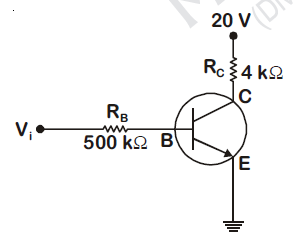

$I_{B}=20\mu A, I_{C} = 5mA, \beta=250$
$I_{B}=25\mu A, I_{C} = 5mA, \beta=200$
$I_{B}=40\mu A, I_{C} = 10mA, \beta=250$
$I_{B}=40\mu A, I_{C} = 5mA, \beta=125$
Explanation:
$V_{BE}=0$
$V_{CE}=0$
$V_{b}=0$

I_{c}= \frac{20-0}{4*10^{3}}$
$I_{c}=5*10^{-3}=5 mA$
$V_{i}=V_{BE}+I_{B}R_{B}$
$V_{i}=0+I_{B}R_{B}$
$20 =I_{B}*500*10^{3}$
$I_{B}= \dfrac{20}{500* 10^{3}}= 40 \mu A$
$\beta=\dfrac{I_{C}}{I_{B}}=\dfrac{25*10^{-3}}{40*10^{-6}}=125$
$V_{BE}=0$
$V_{CE}=0$
$V_{b}=0$
I_{c}= \frac{20-0}{4*10^{3}}$
$I_{c}=5*10^{-3}=5 mA$
$V_{i}=V_{BE}+I_{B}R_{B}$
$V_{i}=0+I_{B}R_{B}$
$20 =I_{B}*500*10^{3}$
$I_{B}= \dfrac{20}{500* 10^{3}}= 40 \mu A$
$\beta=\dfrac{I_{C}}{I_{B}}=\dfrac{25*10^{-3}}{40*10^{-6}}=125$
44782.In a p-n junction diode, change in temperature due to heating
Does not affect resistance of p-n junction
Affects only forward resistance
Affects only reverse resistance
Affects the overall V - I characteristics of p-n junction
Explanation:
Due to heating, number of electron-hole pairs will increase, so overall resistance of diode will change. Due to which forward biasing and reversed biasing both are changed.
Due to heating, number of electron-hole pairs will increase, so overall resistance of diode will change. Due to which forward biasing and reversed biasing both are changed.
44783.In the combination of the following gates the output Y can be written in terms of inputs A and B as


$\overline{A.B}+A.B$
$A.\overline{B}+\overline{A}.B$
$\overline{A.B}$
$\overline{A+B}$
Explanation:

$Y= (A.\overline{B}+\overline{A}.B)$
$Y= (A.\overline{B}+\overline{A}.B)$
44784.An em wave is propagating in a medium with a velocity $\overrightarrow{V}= V\hat{i}$. The instantaneous oscillating electric field of this em wave is along +y axis. Then the direction of oscillating magnetic field of the em wave will be along
–y direction
+z direction
–z direction
–x direction
Explanation:
$\overrightarrow{E}\times\overrightarrow{B}=\overrightarrow{V}$
$(\overrightarrow{E}\hat{j})\times(\overrightarrow{B})=\overrightarrow{V}\hat{i}$
So, $\overrightarrow{B}=B\hat{k}$
Direction of propagation is along +z direction.
$\overrightarrow{E}\times\overrightarrow{B}=\overrightarrow{V}$
$(\overrightarrow{E}\hat{j})\times(\overrightarrow{B})=\overrightarrow{V}\hat{i}$
So, $\overrightarrow{B}=B\hat{k}$
Direction of propagation is along +z direction.
44785.The refractive index of the material of a prism is $\sqrt{2}$ and the angle of the prism is 30°. One of the two refracting surfaces of the prism is made a mirror inwards, by silver coating. A beam of monochromatic light entering the prism from the other face will retrace its path (after reflection from the silvered surface) if its angle of incidence on the prism is
30°
45°
60°
Zero
Explanation:
For retracing its path, light ray should be normally incident on silvered face.

Applying Snells law at M,
$\dfrac{sin i}{sin 30°}=\dfrac{\sqrt{2}}{1}$
$\Rightarrow sin i = \sqrt{2}\times\dfrac{1}{2}$
$ sin i = \dfrac{1}{\sqrt{2}} i.e. i= 45°$
For retracing its path, light ray should be normally incident on silvered face.
Applying Snells law at M,
$\dfrac{sin i}{sin 30°}=\dfrac{\sqrt{2}}{1}$
$\Rightarrow sin i = \sqrt{2}\times\dfrac{1}{2}$
$ sin i = \dfrac{1}{\sqrt{2}} i.e. i= 45°$
44786.An object is placed at a distance of 40 cm from a concave mirror of focal length 15 cm. If the object is displaced through a distance of 20 cm towards the mirror, the displacement of the image will be
30 cm towards the mirror
36 cm away from the mirror
30 cm away from the mirror
36 cm towards the mirror
Explanation:

$\dfrac{1}{f}= \dfrac{1}{v_{1}}+\dfrac{1}{u}$
$-\frac{1}{15}=\dfrac{1}{v_{1}}-\dfrac{1}{40}$
$\Rightarrow\dfrac{1}{v_{1}}= -\frac{1}{15}+\dfrac{1}{40}$
$v_{1}=-24cm$
When object is displaced by 20 cm towards mirror.
Now, $u_{2}=-20$
$\dfrac{1}{f}=\dfrac{1}{v_{2}}+\dfrac{1}{u_{2}}$
$\dfrac{1}{-15}=\dfrac{1}{v_{2}}-\dfrac{1}{20}$
$\dfrac{1}{v_{2}}= \dfrac{1}{20}-\dfrac{1}{15}$
$v_{2}=-60cm$
So, image shifts away from mirror by = 60 – 24 = 36 cm.
$\dfrac{1}{f}= \dfrac{1}{v_{1}}+\dfrac{1}{u}$
$-\frac{1}{15}=\dfrac{1}{v_{1}}-\dfrac{1}{40}$
$\Rightarrow\dfrac{1}{v_{1}}= -\frac{1}{15}+\dfrac{1}{40}$
$v_{1}=-24cm$
When object is displaced by 20 cm towards mirror.
Now, $u_{2}=-20$
$\dfrac{1}{f}=\dfrac{1}{v_{2}}+\dfrac{1}{u_{2}}$
$\dfrac{1}{-15}=\dfrac{1}{v_{2}}-\dfrac{1}{20}$
$\dfrac{1}{v_{2}}= \dfrac{1}{20}-\dfrac{1}{15}$
$v_{2}=-60cm$
So, image shifts away from mirror by = 60 – 24 = 36 cm.
44787.The magnetic potential energy stored in a certain inductor is 25 mJ, when the current in the inductor is 60 mA. This inductor is of inductance
1.389 H
138.88 H
0.138 H
13.89 H
Explanation:
Energy stored in inductor
$U=\dfrac{1}{2}LI^{2}$
$25\times 10^{-3}= \dfrac{1}{2}\times L\times\left(60\times 10^{-3}\right)^{2}$
$L=\dfrac{25\times2\times 10^{6}\times 10^{-3}}{cd}$
$=\dfrac{500}{36}$
=13.89 H
Energy stored in inductor
$U=\dfrac{1}{2}LI^{2}$
$25\times 10^{-3}= \dfrac{1}{2}\times L\times\left(60\times 10^{-3}\right)^{2}$
$L=\dfrac{25\times2\times 10^{6}\times 10^{-3}}{cd}$
$=\dfrac{500}{36}$
=13.89 H
44788.An electron falls from rest through a vertical distance h in a uniform and vertically upward directed electric field E. The direction of electric field is now reversed, keeping its magnitude the same. A proton is allowed to fall from rest in it through the same vertical distance h. The time of fall of the electron, in comparison to the time of fall of the proton is
10 times greater
5 times greater
Smaller
Equal
Explanation:
$h=\dfrac{1}{2}\dfrac{eE}{m}t^{2}$
$\therefore t= \sqrt{\dfrac{2hm}{eF}}$
$\therefore t \propto\sqrt{m}$ as ‘e’ is same for electron and proton.
∵ Electron has smaller mass so it will take smaller time.
$h=\dfrac{1}{2}\dfrac{eE}{m}t^{2}$
$\therefore t= \sqrt{\dfrac{2hm}{eF}}$
$\therefore t \propto\sqrt{m}$ as ‘e’ is same for electron and proton.
∵ Electron has smaller mass so it will take smaller time.
44789.The electrostatic force between the metal plates of an isolated parallel plate capacitor C having a charge Q and area A, is
Proportional to the square root of the distance between the plates
Linearly proportional to the distance between the plates
Independent of the distance between the plates
Inversely proportional to the distance between the plates
Explanation:
For isolated capacitor Q = Constant
$F_{plate}= \dfrac{Q^{2}}{2A_{\epsilon_{o}}}$
F is Independent of the distance between plates.
For isolated capacitor Q = Constant
$F_{plate}= \dfrac{Q^{2}}{2A_{\epsilon_{o}}}$
F is Independent of the distance between plates.
44790.A tuning fork is used to produce resonance in a glass tube. The length of the air column in this tube can be adjusted by a variable piston. At room temperature of 27ºC two successive resonances are produced at 20 cm and 73 cm of column length. If the frequency of the tuning fork is 320 Hz, the velocity of sound in air at 27ºC is
350 m/s
339 m/s
330 m/s
300 m/s
Explanation:
$v=2(\upsilon)\left[ L_{2}-L_{1}\right]$
$2\times 320\left[73-20\right]\times 10^{-2}$
$339.2 ms^{-1}$
= 339 m/s
$v=2(\upsilon)\left[ L_{2}-L_{1}\right]$
$2\times 320\left[73-20\right]\times 10^{-2}$
$339.2 ms^{-1}$
= 339 m/s
44791.A pendulum is hung from the roof of a sufficiently high building and is moving freely to and fro like a simple harmonic oscillator. The acceleration of the bob of the pendulum is $20 m/s^{2}$ at a distance of 5 m from the mean position. The time period of oscillation is
2 s
$\pi s$
$2\pi s $
1 s
Explanation:
$\mid a\mid= \omega^{2}y$
$\Rightarrow 20= \omega^{2}(5)$
$\omega= 2 rad/s$
$T=\dfrac{2\pi}{\omega}=\dfrac{2\pi}{2}=\pi s$
$\mid a\mid= \omega^{2}y$
$\Rightarrow 20= \omega^{2}(5)$
$\omega= 2 rad/s$
$T=\dfrac{2\pi}{\omega}=\dfrac{2\pi}{2}=\pi s$
44792.A metallic rod of mass per unit length 0.5 kg $m^{-1}$ is lying horizontally on a smooth inclined plane which makes an angle of 30° with the horizontal. The rod is not allowed to slide down by flowing a current through it when a magnetic field of induction 0.25 T is acting on it in the vertical direction. The current flowing in the rod to keep it stationary is
14.76 A
5.98 A
7.14 A
11.32 A
Explanation:
For equilibrium,
mg sin30° = I/B cos 30°
$I=\dfrac{mg}{lB}tan 30°$

$\dfrac{0.5\times 9.8}{0.25 \times\sqrt{3}}= 11.32A$
For equilibrium,
mg sin30° = I/B cos 30°
$I=\dfrac{mg}{lB}tan 30°$
$\dfrac{0.5\times 9.8}{0.25 \times\sqrt{3}}= 11.32A$
44793.A thin diamagnetic rod is placed vertically between the poles of an electromagnet. When the current in the electromagnet is switched on, then the diamagnetic rod is pushed up, out of the horizontal magnetic field. Hence the rod gains gravitational potential energy. The work required to do this comes from
The lattice structure of the material of the rod
The magnetic field
The current source
The induced electric field due to the changing magnetic field
Explanation:
Energy of current source will be converted into potential energy of the rod.
Energy of current source will be converted into potential energy of the rod.
44794.An inductor 20 mH, a capacitor 100$\mu F$ and a resistor 50Ω are connected in series across a source of emf, V = 10 sin 314 t. The power loss in the circuit is
2.74 W
0.43 W
0.79 W
1.13 W
Explanation:
$P_{av}=\left(\dfrac{V_{RMS}}{Z}\right)^2R$
$Z=\sqrt{R^2+\left(\omega L - \dfrac{1}{\omega C}\right)^2}= 56Ω$
$\therefore P_{av}=\left[\dfrac{10}{\left(\sqrt{2}\right)56}\right]^2\times 50=0.79W$
$P_{av}=\left(\dfrac{V_{RMS}}{Z}\right)^2R$
$Z=\sqrt{R^2+\left(\omega L - \dfrac{1}{\omega C}\right)^2}= 56Ω$
$\therefore P_{av}=\left[\dfrac{10}{\left(\sqrt{2}\right)56}\right]^2\times 50=0.79W$
44795.Current sensitivity of a moving coil galvanometer is 5 div/mA and its voltage sensitivity (angular deflection per unit voltage applied) is 20 div/V. The resistance of the galvanometer is
250 Ω
25 Ω
40 Ω
500 Ω
Explanation:
Current sensitivity
$I_{S}=\dfrac{NBA}{C}$
Voltage sensitivity
$V_{S}=\dfrac{NBA}{CR_{G}}$
So, resistance of galvanometer
$R_{G}=\dfrac{I_{S}}{V_{S}}=\dfrac{5\times 1}{20 \times 10^{-3}}=\dfrac{5000}{20}=250 Ω$
Current sensitivity
$I_{S}=\dfrac{NBA}{C}$
Voltage sensitivity
$V_{S}=\dfrac{NBA}{CR_{G}}$
So, resistance of galvanometer
$R_{G}=\dfrac{I_{S}}{V_{S}}=\dfrac{5\times 1}{20 \times 10^{-3}}=\dfrac{5000}{20}=250 Ω$
44796.A body initially at rest and sliding along a frictionless track from a height h (as shown in the figure) just completes a vertical circle of diameter AB = D. The height h is equal to
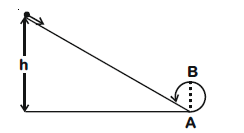

$\dfrac{7}{5}D$
D
$\dfrac{3}{2}D$
$\dfrac{5}{4}D$
Explanation:

As track is frictionless, so total mechanical energy will remain constant
$T.M.E_I=T.M.E_F$
$0+mgh = \dfrac{1}{2}mv_L^2+0 $
$h=\dfrac{v_L^2}{2g}$
For completing the vertical circle, $v_{L}\geq\sqrt{5gR}$
$h=\dfrac{5gR}{2g}=\dfrac{5}{2}R=\dfrac{5}{4}D$
As track is frictionless, so total mechanical energy will remain constant
$T.M.E_I=T.M.E_F$
$0+mgh = \dfrac{1}{2}mv_L^2+0 $
$h=\dfrac{v_L^2}{2g}$
For completing the vertical circle, $v_{L}\geq\sqrt{5gR}$
$h=\dfrac{5gR}{2g}=\dfrac{5}{2}R=\dfrac{5}{4}D$
44797.Three objects, A : (a solid sphere), B : (a thin circular disk) and C : (a circular ring), each have the same mass M and radius R. They all spin with the same angular speed $\omega$ about their own symmetry axes. The amounts of work (W) required to bring them to rest, would satisfy the relation
$W_{B}>W_{A}>W_{C}$
$W_{A}>W_{B}>W_{C}$
$W_{C}>W_{B}>W_{A}$
$W_{A}>W_{C}>W_{B}$
Explanation:
Work done required to bring them rest
$\triangle W=\triangle KE$
$\triangle W=\dfrac{1}{2}l\omega^{2}$
$\triangle W\propto I for same \omega$
$W_{A}:W_{B}:W_{C} = \dfrac{2}{5}MR^2:\dfrac{1}{2}MR^2:MR^2$
$\dfrac{2}{5}:\dfrac{1}{2}:1$
$4:5:10$
$\Rightarrow W_{C}>W_{B}>W_{A}$
Work done required to bring them rest
$\triangle W=\triangle KE$
$\triangle W=\dfrac{1}{2}l\omega^{2}$
$\triangle W\propto I for same \omega$
$W_{A}:W_{B}:W_{C} = \dfrac{2}{5}MR^2:\dfrac{1}{2}MR^2:MR^2$
$\dfrac{2}{5}:\dfrac{1}{2}:1$
$4:5:10$
$\Rightarrow W_{C}>W_{B}>W_{A}$
44798.A moving block having mass m, collides with another stationary block having mass 4m. The lighter block comes to rest after collision. When the initial velocity of the lighter block is v, then the value of coefficient of restitution (e) will be
0.8
0.25
0.5
0.4
Explanation:
According to law of conservation of linear momentum, $mv + 4m\times 0= 4m\acute{v}+0$
$\acute{v}=\dfrac{v}{4}$
$e=\dfrac{Relative velocity of separation}{Relative velocity of approach}=\dfrac{\frac{v}{4}}{v}$
$e=\dfrac {1}{4}=0.25$
According to law of conservation of linear momentum, $mv + 4m\times 0= 4m\acute{v}+0$
$\acute{v}=\dfrac{v}{4}$
$e=\dfrac{Relative velocity of separation}{Relative velocity of approach}=\dfrac{\frac{v}{4}}{v}$
$e=\dfrac {1}{4}=0.25$
44799.Which one of the following statements is incorrect?
Frictional force opposes the relative motion.
Limiting value of static friction is directly proportional to normal reaction.
Rolling friction is smaller than sliding friction.
Coefficient of sliding friction has dimensions of length.
Explanation:
Coefficient of sliding friction has no dimension.
$f=\mu_{S}N$
$\mu_{S}=\dfrac{f}{N}$
Coefficient of sliding friction has no dimension.
$f=\mu_{S}N$
$\mu_{S}=\dfrac{f}{N}$
44800.A toy car with charge q moves on a frictionless horizontal plane surface under the influence of a uniform electric field $\vec{E}$ Due to the force q $\vec{E}$ E , its velocity increases from 0 to 6 m/s in one second duration. At that instant the direction of the field is reversed. The car continues to move for two more seconds under the influence of this field. The average velocity and the average speed of the toy car between 0 to 3 seconds are respectively
1 m/s, 3.5 m/s
1 m/s, 3 m/s
2 m/s, 4 m/s
1.5 m/s, 3 m/s
Explanation:

Acceleration a =$\dfrac{6-0}{1}=6ms^{-2}$
For t = 0 to t = 1 s,
$S_{1}=\dfrac{1}{2}\times 6\left(1\right)^2=3m\cdot\cdot\cdot(i)$
For t = 1 s to t = 2 s,
$S_{2}=6.1 - \dfrac{1}{2}\times 6\left(1\right)^2=-3m\cdot\cdot\cdot(ii)$
For t = 2 s to t = 3 s,
$S_{3}=0 - \dfrac{1}{2}\times 6\left(1\right)^2=-3m\cdot\cdot\cdot(iii)$
Total displacement S =$S_{1}+S_{2}+S_{3}=3m$
Average velocity=$\dfrac{3}{3}=1ms^{-1}$
Total distance travelled = 9 m
Average speed =$\dfrac{9}{3}= 3ms^{-1}$
Acceleration a =$\dfrac{6-0}{1}=6ms^{-2}$
For t = 0 to t = 1 s,
$S_{1}=\dfrac{1}{2}\times 6\left(1\right)^2=3m\cdot\cdot\cdot(i)$
For t = 1 s to t = 2 s,
$S_{2}=6.1 - \dfrac{1}{2}\times 6\left(1\right)^2=-3m\cdot\cdot\cdot(ii)$
For t = 2 s to t = 3 s,
$S_{3}=0 - \dfrac{1}{2}\times 6\left(1\right)^2=-3m\cdot\cdot\cdot(iii)$
Total displacement S =$S_{1}+S_{2}+S_{3}=3m$
Average velocity=$\dfrac{3}{3}=1ms^{-1}$
Total distance travelled = 9 m
Average speed =$\dfrac{9}{3}= 3ms^{-1}$
44801.A block of mass m is placed on a smooth inclined wedge ABC of inclination $\theta$ as shown in the figure. The wedge is given an acceleration a towards the right. The relation between a and $\theta$ for the block to remain stationary on the wedge is
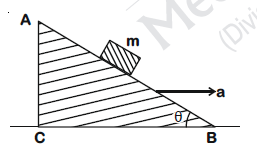

a = g cos $\theta$
a = $\dfrac{g}{sin \theta}$
a = $\dfrac{g}{cosec \theta}$
a = $g tan \theta $
Explanation:
 In non-inertial frame,
In non-inertial frame,
$ N sin \theta = ma \cdot\cdot\cdot(i)$
$N \cos \theta = mg \cdot\cdot\cdot(ii)$
$\tan \theta = \dfrac{a}{g}$
$ a = g \tan \theta$
$ N sin \theta = ma \cdot\cdot\cdot(i)$
$N \cos \theta = mg \cdot\cdot\cdot(ii)$
$\tan \theta = \dfrac{a}{g}$
$ a = g \tan \theta$
44802.The moment of the force, $\vec{F}=4\hat{i}+5\hat{j}-6\hat{k}$ at (2, 0, –3), about the point (2, –2, –2), is given by
$-7ˆi -8ˆj - 4kˆ$
$-4ˆi -ˆj -8kˆ$
$-8ˆi -4ˆj -7kˆ$
$-7ˆi -4ˆj -8kˆ$
Explanation:

$\vec{\tau}=\left(\vec{r}-\vec{r_{0}}\right)\times\vec{F} \cdot\cdot\cdot(i)$
$\vec{r}-\vec{r_{0}}= \left(2\hat{i}+0\hat{j}-3\hat{k}\right)-\left(2\hat{i}-2\hat{j}-2\hat{k}\right)$
$0\hat{i}+2\hat{j}-\hat{k}$

$\vec{\tau}=\left(\vec{r}-\vec{r_{0}}\right)\times\vec{F} \cdot\cdot\cdot(i)$
$\vec{r}-\vec{r_{0}}= \left(2\hat{i}+0\hat{j}-3\hat{k}\right)-\left(2\hat{i}-2\hat{j}-2\hat{k}\right)$
$0\hat{i}+2\hat{j}-\hat{k}$
44803.A student measured the diameter of a small steel ball using a screw gauge of least count 0.001 cm. The main scale reading is 5 mm and zero of circular scale division coincides with 25 divisions above the reference level. If screw gauge has a zero error of –0.004 cm, the correct diameter of the ball is
0.053 cm
0.525 cm
0.521 cm
0.529 cm
Explanation:
Diameter of the ball
= MSR + CSR × (Least count) – Zero error
= 0.5 cm + 25 × 0.001 – (–0.004)
= 0.5 + 0.025 + 0.004
= 0.529 cm
Diameter of the ball
= MSR + CSR × (Least count) – Zero error
= 0.5 cm + 25 × 0.001 – (–0.004)
= 0.5 + 0.025 + 0.004
= 0.529 cm
44804.A solid sphere is rotating freely about its symmetry axis in free space. The radius of the sphere is increased keeping its mass same. Which of the following physical quantities would remain constant for the sphere?
Rotational kinetic energy
Moment of inertia
Angular velocity
Angular momentum
Explanation:
$\tau_{ex}= 0$
So, $\dfrac{dL}{dt} = 0$
i.e. L = constant
So angular momentum remains constant.
$\tau_{ex}= 0$
So, $\dfrac{dL}{dt} = 0$
i.e. L = constant
So angular momentum remains constant.
44805.The kinetic energies of a planet in an elliptical orbit about the Sun, at positions A, B and C are $K_{A}, K_{B}$ and $K_{C}$, respectively. AC is the major axis and SB is perpendicular to AC at the position of the Sun S as shown in the figure. Then 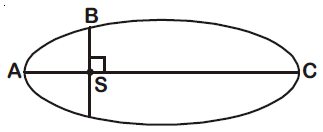

$ K_{B} < K_{A} < K_{C} $
$ K_{A} > K_{B} > K_{C} $
$ K_{A} < K_{B} < K_{C} $
$ K_{B} > K_{A} > K_{C} $
Explanation:

Point A is perihelion and C is aphelion.
So, $V_{A}>V_{B}>V_{C}$
So, $K_{A}>K_{B}>K_{C}$
Point A is perihelion and C is aphelion.
So, $V_{A}>V_{B}>V_{C}$
So, $K_{A}>K_{B}>K_{C}$
44806.If the mass of the Sun were ten times smaller and the universal gravitational constant were ten times larger in magnitude, which of the following is not correct?
Time period of a simple pendulum on the Earth would decrease
Walking on the ground would become more difficult
Raindrops will fall faster
‘g’ on the Earth will not change
Explanation:
If Universal Gravitational constant becomes ten times, then $\acute{G}$ = 10 G So, acceleration due to gravity increases. i.e. (4) is wrong option.
If Universal Gravitational constant becomes ten times, then $\acute{G}$ = 10 G So, acceleration due to gravity increases. i.e. (4) is wrong option.
44807.A solid sphere is in rolling motion. In rolling motion a body possesses translational kinetic energy $\left(K_{t}\right)$ as well as rotational kinetic energy $\left(K_{t}\right)$ simultaneously. The ratio $K_{t}:\left(K_{t}+K_{r}\right)$ for the sphere is
10 : 7
5 : 7
7 : 10
2 : 5
Explanation:
$K_{t}=\dfrac{1}{2}mv^2$
$K_{t}+K_{r}=\dfrac{1}{2}mv^2 +\dfrac{1}{2}l\omega ^2=\dfrac{1}{2}mv^2 +\dfrac{1}{2}\left(\dfrac{2}{5}mr^2\right)\left(\dfrac{v}{r}\right)^2$
$\dfrac{7}{10}mv^2$
So,$\dfrac{K_{t}}{K_{t}+K_{r}}=\dfrac{5}{7}$
$K_{t}=\dfrac{1}{2}mv^2$
$K_{t}+K_{r}=\dfrac{1}{2}mv^2 +\dfrac{1}{2}l\omega ^2=\dfrac{1}{2}mv^2 +\dfrac{1}{2}\left(\dfrac{2}{5}mr^2\right)\left(\dfrac{v}{r}\right)^2$
$\dfrac{7}{10}mv^2$
So,$\dfrac{K_{t}}{K_{t}+K_{r}}=\dfrac{5}{7}$
44808.A small sphere of radius r falls from rest in a viscous liquid. As a result, heat is produced due to viscous force. The rate of production of heat when the sphere attains its terminal velocity, is proportional to
$r^{5}$
$r^{2}$
$r^{3}$
$r^{4}$
Explanation:
Power = $6\pi\eta rV_{T}.V_{T} = 6\pi\eta rV_T^2$
$V_{T}\propto r^{2}$
$\Rightarrow Power\propto r^5$
Power = $6\pi\eta rV_{T}.V_{T} = 6\pi\eta rV_T^2$
$V_{T}\propto r^{2}$
$\Rightarrow Power\propto r^5$
44809.The power radiated by a black body is P and it radiates maximum energy at wavelength, $\lambda_0$. If the temperature of the black body is now changed so that it radiates maximum energy at wavelength $\dfrac{3}{4}\lambda_0$, 4 the power radiated by it becomes nP. The value of n is
$\dfrac{256}{81}$
$\dfrac{4}{3}$
$\dfrac{3}{4}$
$\dfrac{81}{256}$
Explanation:
We know,
$\lambda_{max} T= constant (Wiens law)$
So, $\lambda_{max_1} T_1=\lambda_{max_2} T_2$
$\Rightarrow \lambda_0 T=\dfrac{3 \lambda_0}{4}\acute{T}$
$\Rightarrow \acute{T} =\dfrac{4}{3}T$
$ So, \dfrac{P_2}{P_1}= \left(\dfrac{\acute{T}}{T}\right)^4=\left(\dfrac{4}{3}\right)^4=\dfrac{256}{81}$
We know,
$\lambda_{max} T= constant (Wiens law)$
So, $\lambda_{max_1} T_1=\lambda_{max_2} T_2$
$\Rightarrow \lambda_0 T=\dfrac{3 \lambda_0}{4}\acute{T}$
$\Rightarrow \acute{T} =\dfrac{4}{3}T$
$ So, \dfrac{P_2}{P_1}= \left(\dfrac{\acute{T}}{T}\right)^4=\left(\dfrac{4}{3}\right)^4=\dfrac{256}{81}$
44810.Two wires are made of the same material and have the same volume. The first wire has cross-sectional area A and the second wire has cross-sectional area 3A. If the length of the first wire is increased by $\triangle l$ on applying a force F, how much force is needed to stretch the socond wire by the same amount?
4 F
6 F
9 F
F
Explanation:

For wire 1,
$\triangle l =\left(\dfrac{F}{AY}\right)3l \cdot\cdot\cdot(i)$
For wire 2,
$\dfrac{\acute{F}}{3A}=Y\dfrac{\triangle l}{l}$
$\triangle l =\left(\dfrac{\acute{F}}{3AY}\right)l \cdot\cdot\cdot(ii)$
From equation (i) & (ii),
$ \triangle l= \left(\dfrac{F}{AY}\right)3l= \left(\dfrac{\acute{F}}{3AY}\right)l$
$\Rightarrow \acute{F}=9F$
For wire 1,
$\triangle l =\left(\dfrac{F}{AY}\right)3l \cdot\cdot\cdot(i)$
For wire 2,
$\dfrac{\acute{F}}{3A}=Y\dfrac{\triangle l}{l}$
$\triangle l =\left(\dfrac{\acute{F}}{3AY}\right)l \cdot\cdot\cdot(ii)$
From equation (i) & (ii),
$ \triangle l= \left(\dfrac{F}{AY}\right)3l= \left(\dfrac{\acute{F}}{3AY}\right)l$
$\Rightarrow \acute{F}=9F$
44811.A sample of 0.1 g of water at 100°C and normal pressure $(1.013 × 10^{5}Nm^{-2})$ requires 54 cal of heat energy to convert to steam at 100°C. If the volume of the steam produced is 167.1 cc, the change in internal energy of the sample, is
42.2 J
208.7 J
104.3 J
84.5 J
Explanation:
$\triangle Q=\triangle U+\triangle W$
$\Rightarrow 54 \times 4.18 =\triangle U +1.013 \times 10^{5}(167.1 \times 10^{-6}-0)$
$\Rightarrow \triangle U=208.7 J$
$\triangle Q=\triangle U+\triangle W$
$\Rightarrow 54 \times 4.18 =\triangle U +1.013 \times 10^{5}(167.1 \times 10^{-6}-0)$
$\Rightarrow \triangle U=208.7 J$
44812.The correct order of N-compounds in its decreasing order of oxidation states is
$HNO_3, NH_4CL, NO, N_2$
$HNO_3, NO, NH_4CL, N_2$
$HNO_3, NO, N_2, NH_4CL$
$NH_4CL, N_2, NO, HNO_3$
Explanation:

44813.Which one of the following elements is unable to form $MF_6^{3-}$ ion?
B
Al
Ga
In
Explanation:
∵ B has no vacant d-orbitals in its valence shell, so it cant extend its covalency beyond 4. i.e. B cannot form the ion like $MF_6^{(3-)}$ i.e. $BF_6^{(3-)}$. Hence, the correct option is (1).
∵ B has no vacant d-orbitals in its valence shell, so it cant extend its covalency beyond 4. i.e. B cannot form the ion like $MF_6^{(3-)}$ i.e. $BF_6^{(3-)}$. Hence, the correct option is (1).
44814.Considering Ellingham diagram, which of the following metals can be used to reduce alumina?
Mg
Zn
Fe
Cu
Explanation:
The metal which is more reactive than Al can reduce alumina i.e. Mg should be the correct option.
The metal which is more reactive than Al can reduce alumina i.e. Mg should be the correct option.
44815.The correct order of atomic radii in group 13 elements is
B < Ga < Al < Tl < In
B < Al < Ga < In < Tl
B < Al < In < Ga < Tl
B < Ga < Al < In < Tl
Explanation:

44816.Which of the following statements is not true for halogens?
All but fluorine show positive oxidation states
All are oxidizing agents
All form monobasic oxyacids
Chlorine has the highest electron-gain enthalpy
Explanation:
Due to high electronegativity and small size, F forms only one oxoacid, HOF known as Fluoric (I) acid. Oxidation number of F is +1 in HOF.
Due to high electronegativity and small size, F forms only one oxoacid, HOF known as Fluoric (I) acid. Oxidation number of F is +1 in HOF.
44817.In the structure of $ClF_3$, the number of lone pair of electrons on central atom ‘Cl’ is
Four
Two
One
Three
Explanation:
The structure of $ClF_3$ is
The number of lone pair of electrons on central Cl is 2.
The structure of $ClF_3$ is
The number of lone pair of electrons on central Cl is 2.
44818.Identify the major products P, Q and R in the following sequence of reactions:
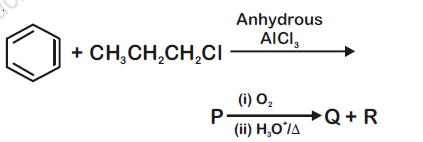



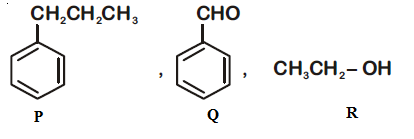

Explanation:

Now,

Now,
44819.Which of the following compounds can form a zwitterion?
Benzoic acid
Acetanilide
Aniline
Glycine
Explanation:

44820.Regarding cross-linked or network polymers, which of the following statements is incorrect?
Examples are bakelite and melamine.
They are formed from bi- and tri-functional monomers.
They contain covalent bonds between various linear polymer chains.
They contain strong covalents bonds in their polymer chains.
Explanation:
Cross linked or network polymers are formed from bi-functional and tri-functional monomers and contain strong covalent bonds between various linear polymer chains, e.g. bakelite, melamine etc. Option (4) is not related to cross-linking. So option (4) should be the correct option.
Cross linked or network polymers are formed from bi-functional and tri-functional monomers and contain strong covalent bonds between various linear polymer chains, e.g. bakelite, melamine etc. Option (4) is not related to cross-linking. So option (4) should be the correct option.
44821.Nitration of aniline in strong acidic medium also gives m-nitroaniline because
In absence of substituents nitro group always goes to m-position.
In electrophilic substitution reactions amino group is meta directive.
Inspite of substituents nitro group always goes to only m-position.
In acidic (strong) medium aniline is present as anilinium ion.
Explanation:

$-N^\oplus H_3$ is m-directing, hence besides para (51%) and ortho (2%), meta product (47%) is also formed in significant yield.
$-N^\oplus H_3$ is m-directing, hence besides para (51%) and ortho (2%), meta product (47%) is also formed in significant yield.
44822.The difference between amylose and amylopectin is
Amylopectin have $1\rightarrow4 \alpha$-linkage and $1\rightarrow 6 \beta$-linkage
Amylose have $1\rightarrow4 \alpha$-linkage and $1\rightarrow 6 \beta$-linkage
Amylopectin have $1\rightarrow4 \alpha$-linkage and $1\rightarrow 6 \alpha$-linkage
Amylose is made up of glucose and galactose
Explanation:
Amylose and Amylopectin are polymers of $\alpha$-D-glucose, so $\beta$-link is not possible. Amylose is linear with $1\rightarrow4 \alpha$-linkage whereas Amylopectin is branched and has both $1\rightarrow4$ and $1\rightarrow6 \alpha$-linkages. So option (3) should be the correct option.
Amylose and Amylopectin are polymers of $\alpha$-D-glucose, so $\beta$-link is not possible. Amylose is linear with $1\rightarrow4 \alpha$-linkage whereas Amylopectin is branched and has both $1\rightarrow4$ and $1\rightarrow6 \alpha$-linkages. So option (3) should be the correct option.
44823.A mixture of 2.3 g formic acid and 4.5 g oxalic acid is treated with conc. $H_2SO_4$. The evolved gaseous mixture is passed through KOH pellets. Weight (in g) of the remaining product at STP will be
2.8
3.0
1.4
4.4
Explanation:

Gaseous mixture formed is CO and $CO_2$ when it is passed through KOH, only $CO_2$ is absorbed. So the remaining gas is CO. So, weight of remaining gaseous product CO is
$\dfrac{2}{20}\times 28=2.8g$
So, the correct option is (1)
Gaseous mixture formed is CO and $CO_2$ when it is passed through KOH, only $CO_2$ is absorbed. So the remaining gas is CO. So, weight of remaining gaseous product CO is
$\dfrac{2}{20}\times 28=2.8g$
So, the correct option is (1)
44824.Which of the following oxides is most acidic in nature?
BaO
BeO
MgO
CaO
Explanation:

So, the most acidic should be BeO. In fact, BeO is amphoteric oxide while other given oxides are basic.
So, the most acidic should be BeO. In fact, BeO is amphoteric oxide while other given oxides are basic.
44825.Which oxide of nitrogen is not a common pollutant introduced into the atmosphere both due to natural and human activity?
$N_2O$
$NO_2$
$N_2O_5$
NO
Explanation:
Fact
Fact
44826.The compound A on treatment with Na gives B, and with $PCl_5$ gives C. B and C react together to give diethyl ether. A, B and C are in the order
$C_2H_5Cl, C_2H_6, C_2H_5OH$
$C_2H_5OH, C_2H_5Cl, C_2H_5ONa$
$C_2H_5OH, C_2H_6, C_2H_5Cl$
$C_2H_5OH, C_2H_5ONa, C_2H_5Cl$
Explanation:

So the correct option is (4)
So the correct option is (4)
